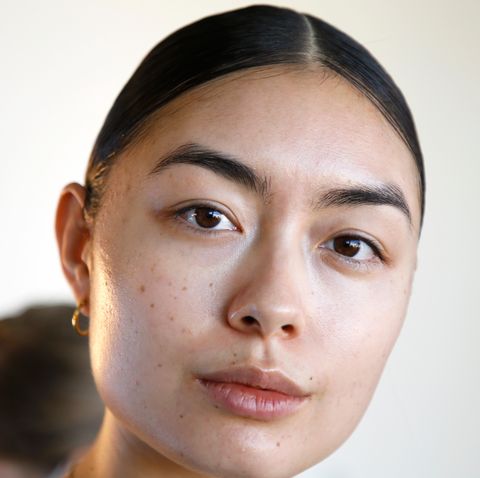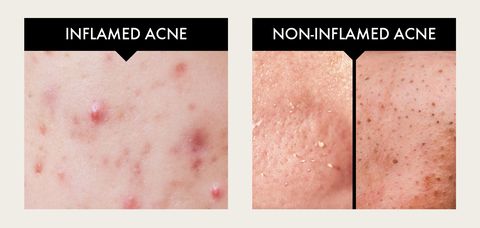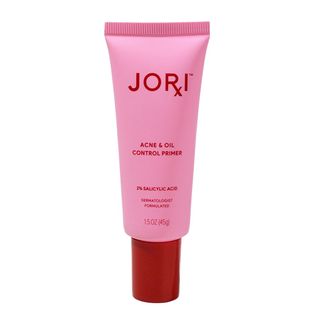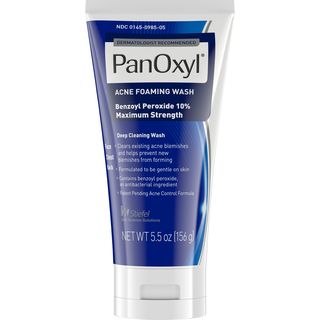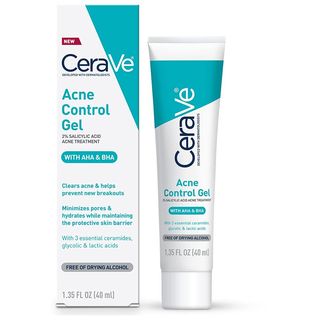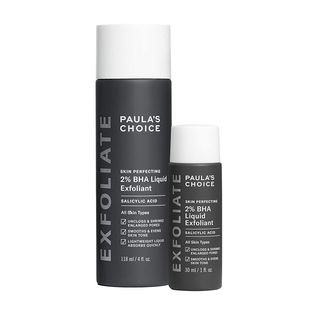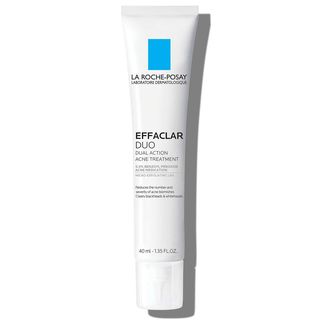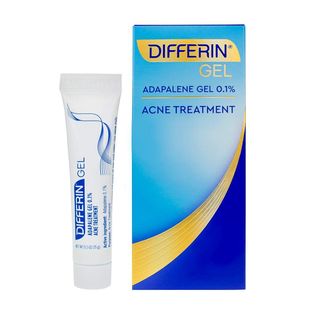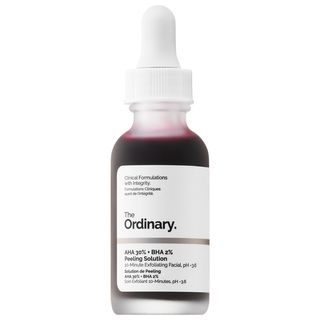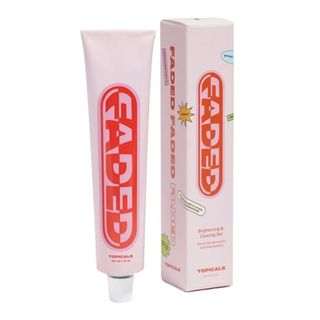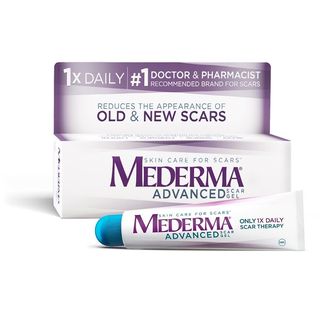Products You May Like
For a solid 23 and a half years, my skin was on its best behavior. Occasionally, I’d have a mild breakout, but it usually resolved within a week without much effort. And then suddenly, around six months ago, my skin launched a full-on revolt. No sooner would a pimple on my chin fade away than another one would pop up next door. They were painful and unpleasant, and my usual tactic of going about my business was not solving anything.
Developing acne for the first time as an adult is a jarring experience. According to Dr. Joshua Zeichner, MD, one of the foremost acne specialists, my breakouts fell into the category of new-onset acne. “These are people who never had breakouts when they were younger and then felt acne for the first time as an adult,” says Dr. Zeichner. So, with my clear-skin smugness rapidly fading, I dived headfirst into finding out everything there is to know about how to prevent acne, treat it, and finally, get rid of the lingering marks that like to hang around.
According to the American Academy of Dermatology Association, acne affects around 50 million American annually. 85% of people between the ages of 12 and 24 are affected, and the numbers are increasing. And yet, it can still feel like when we encounter either a single whitehead or persisting cystic acne, it feels like finding the proper, effective treatments are few and far between. “We know that acne has huge psychological impacts,” says Dr. Zeichner. Breakouts can lead to a whole host of mental reactions, including anxiety. That anxiety can increase the body’s stress hormones, which, in turn, can lead to more acne. And so, the cycle continues.
What Are The Different Types Of Acne?
Inflamed vs. Non-Inflamed Acne
Sofie Pavitt, a licensed esthetician and certified acne specialist, sees many different types of acne in her New York City skin care studio. “We determine what type of acne someone has and then what ‘grade’ it is,” Pavitt tells ELLE.com. “There are many types of acne, but the two most common types are inflamed and non-inflamed acne.” Determining whether your skin is inflamed or non-inflamed can inform the most beneficial treatments. “Inflamed acne is when pimples present, with pustules, papules, skin feels hot to the touch and painful little pimples with pus in them,” adds Pavitt. “Non-inflamed acne is when your skin has rough, pebbly texture, blackheads, but no inflammation. It’s common to have a mixture of the two types.”
Depending on whether your breakouts are inflamed or non-inflamed can dramatically impact the treatments that will be effective. Some non-inflamed breakouts can benefit from physical exfoliators, like facial scrubs. However, physically exfoliating inflamed acne can only exacerbate the problem.
What do different acne types look like?
Dermatologist Dr. Karan Lal, DO, FAAD, breaks this down even further. The major types of acne include:
- Comedonal acne: presents with blackheads and whiteheads
- Inflammatory acne: presents with red bumps and pus bumps
- Inodulocystic acne: presents with nodules and cysts that are often extremely painful
- Hormonal acne: presents with pimples on the jawline and chin in women that flare with periods
- Pityrosporum folliculitis: yeast acne that presents with bumps on the forehead, back, and shoulders that are often itchy
However, self-diagnosing the type of acne can you have can present its challenges. “Pityrosporum folliculitis is a great mimicker of true acne and is often misclassified as ‘fungal acne,'” says Dr. Lal. “In this form of acne, you don’t have black and whiteheads; instead, you have skin-colored bumps on the forehead, shoulders, and back. It is more common in darker-skinned patients that have oily skin.” Typical acne remedies are often ineffective against Pityrosporum folliculitis, which makes a proper diagnosis vital. When in doubt, seeking out a dermatologist’s opinion can take some of the guesswork out of treatment.
What Causes Acne?
When confronted with my newfound blemishes, I made a list of everything I had added to my routine that could have affected my skin. Did we switch detergent brands? Was a new product to blame? Did I not wash my towels enough? Speaking to Pavitt, she had another theory: Like many people, I probably have a genetic disposition to breaking out, which I had successfully masked with the help of hormonal birth control since I was a teenager. Now, as an adult, that cure-all has stopped working with changing hormones. And that means that I have to treat my skin differently.
This is in line with the most common causes of acne. “The three main causative factors–based on decades of published research into sebaceous gland biology and acne —are hormones, diet, and stress.” So, in addition to plain, old genetics, hormones, diet, and stress are the trigger that can make an adult develop acne, whether they’ve struggled with it before or are first-timers like me.
Genetics
“All acne forms when somebody has a predisposition to it,” says Pavitt. “Some people are more predisposed to acne because their pores shed faster than somebody who isn’t predisposed to acne–this is genetic and carries through families.” Your pores can get clogged when you combine a high shedding rate with excess oils, diet, stress, or hormones. Then, a bacteria known as Cutibacterium acne shows up, eats the dead skin and oils collected on your face, and can cause an infection in your pores–also known as acne.
Hormones and Acne
If you’ve ever wondered why you begin to develop pimples during your period, hormones are to blame. Androgen hormones, like testosterone and Dihydrotestosterone (also known as DHT), are present in everybody, and these hormones are responsible for stimulating oil glands. “That increases oil production and inflammation,” says Dr. Zeichner.
Diet and Acne
Unfortunately for me and my never-ending love for dairy and sugar, what we eat impacts our skin. According to Dr. Zeichner, some foods most commonly linked to acne are “sugary and starchy foods, foods with refined sugars, and cows milk. Interestingly, cheese and yogurt are not associated with breakouts, but cow’s milk, especially skim milk, are associated with breakouts.” In addition, B12 supplements and protein supplements can also cause acne. (This felt like a monumental betrayal because I had been happily popping my B12 pills per my doctor’s request.) However, in a surprising twist, greasy foods aren’t linked to an increase in breakouts. “The big joke I have with people is if you’re going to get a burger and a milkshake, it’s not the burger or the grease associated with acne, but rather the bun and the shake.”
Stress and Acne
“Stress acne is real, and this has been well documented,” says Dr. Zeichner, delivering yet another blow to me as I am constantly stressed. “Many people attribute stress breakouts to cortisol, and that’s been published in the media, but that’s incorrect.” When in a stressful environment, your body releases CRH–corticotropin-releasing hormone–which triggers cortisol. “But it also stimulates your oil glands again, leading to oil production and inflammation,” says Dr. Zeichner.
How Do You Treat Acne?
Once you’ve correctly identified the type or types of acne you have, whether it’s self-diagnosed or you’ve spoken to an acne professional, the next step is treatment. Here, there are two main categories: at-home and in-office.
What are at-home acne treatments?
The most common and beneficial home acne treatment is investing in quality skincare–and that doesn’t necessarily mean products with a hefty price tag. “You don’t need a lot when it comes to treatment,” says Dr. Lal. “Stick with two things.” First, Dr. Lal recommends finding products containing ingredients that kill the acne-causing bacteria, gently exfoliate the skin, and dry out excess oils. “For comedonal acne, adapalene and benzoyl peroxide are the go-to’s,” says Dr. Lal. “Other helpful things include topical sulfur creams or cleansers, which are anti-inflammatory and work by killing acne-causing bacteria. Salicylic acid cleansers are also good at mildly exfoliating and drying out oily skin.” And “If you have pityrosporum folliculitis you want to look for clotrimazole cream and ketoconazole wash which helps kill the yeast that causes this type of acne.” For people genetically predisposed to acne, using chemical exfoliators or physical scrubs (for non-inflamed acne only) can reduce the number of oils and dead skin cells on your face, thereby depriving acne-causing bacteria of their favorite food source. Unfortunately, many products targeted toward people with acne can be robust and dry, so Pavitt recommends pairing them with nourishing ingredients. “You don’t want to compromise your skin barrier with harsh products. But some active exfoliators sandwiched with really nourishing products can be an effective way to treat acne.”
When looking into skincare products, look closely at the claims. “Saying that you treat acne is a drug claim,” says Dr. Zeichner. “So the only way a product can make that claim is to contain an FDA-approved acne medication.” Benzoyl peroxide and salicylic acid are some of the few over-the-counter ingredients approved for acne treatments. In partnership with his wife, Cori Zeichner, the pair created a skincare line called Jori that features two at-home acne treatments developed specifically for adult acne.
One is the Acne and Oil Control Primer with 2% salicylic acid, and the other is the Daily Leave-On Acne Treatment Mask, with 2.5% benzoyl peroxide. “I wanted it to have sophisticated textures that fit in with my skincare routine and could be worn with my makeup,” says Mrs. Zeichner. “You don’t want to have to hide your pimple cream. You want to be able to keep it out on your vanity.”
What are in-office acne treatments?
Visiting a dermatologist or esthetician specializing in acne treatment can be a game-changer. Seeing a specialist means accessing information and medicines unavailable at home. “I recommend people to go to an esthetician who specializes in acne if this is something you’re suffering with,” says Pavitt. A quality esthetician can perform extractions carefully, introduce you to new products, and give treatments like LED light therapy or cryotherapy, which can diminish irritation.
Dermatologists can also prescribe topical or oral medication, depending on your skin’s needs and the severity of your breakouts. “For inflammatory acne, we often will use topical or oral antibiotics to help reduce inflammation,” says Dr. Lal. “We also have new topicals such as Winlevi, an anti-inflammatory anti-hormonal agent. It is great for patients who have hormonal acne. If oral antibiotics aren’t helping or there is rebound upon finishing a course, I bring Accutane into the conversation.”Accutane is an oral medication that works to treat cystic acne and persistent breakouts. It’s not to be taken lightly, but it can work miracles for some people. “I personally find Accutane to be a super safe medication, and it’s the only medication that has long-lasting effects,” says Dr. Lal.
Additional in-office treatments can include light therapy, lasers, and peels for patients who are not interested in oral or topical medication. For example, “064nm lasers such as the Aerolase Neo Elite help reduce inflammatory acne. People start seeing improvement after 48 hours. Usually, multiple treatments are needed, and this is mostly good at treating flares. The new kid on the block is a laser called AviClear. It is a laser that downregulates the sebaceous gland. Excellent data shows long-term improvement after three sessions,” says Dr. Lal.
Finally, “Chemical peels are an old school way of getting rid of blackheads and improving inflammatory acne,” says Dr. Lal. “They are safe for all skin types and can be done as frequently as every two weeks.” However, it’s important to remember that these treatments come at a cost. “All non-medication-based treatments are not covered by insurance, so budget is important,” says Dr. Lal.
How do you treat acne scars?
Once the breakouts are handled, redness, hyperpigmentation, or scarring are the new battle. “Post-acne scars are some of the hardest scars to treat, and this is why we are aggressive about treating acne early in the inflammatory phase so we can minimize or prevent scarring,” says Dr. Lal. “Scarring can be treated with different types of lasers, Microneedling, subcission–when we manually break the scars underneath the skin– chemical peels, and even filler. No one option is better than the other, and multiple sessions and different approaches are needed to treat scars.”
“Redness is a much easier treatment,” says Dr. Lal. “We use devices such as IPL and pulse dye laser to treat the redness associated with acne and scarring. But, again, multiple sessions are required, and they aren’t cheap.” Because so many of the most effective treatments require visits to a dermatologist or plastic surgeon, doing your best to prevent scarring is often the easiest–and cheapest–method. That includes avoiding picking at pimples since that can inadvertently damage your skin more and lead to further breakouts and an increased likelihood of scarring.

